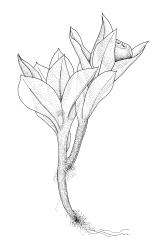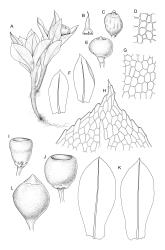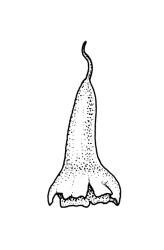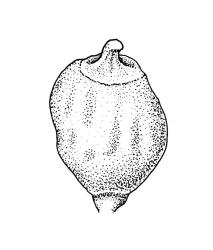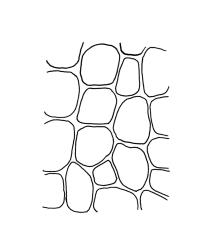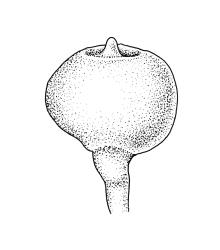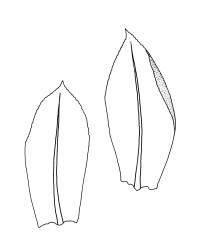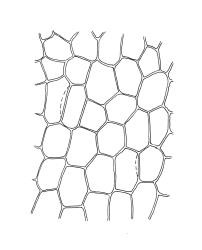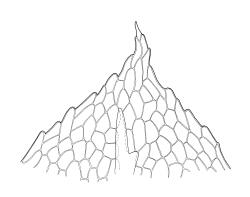Plants very small, yellow- to brown-green. Stems branched once by innovation or occasionally with several innovations, to 4 mm, yellowish- or red-brown, in cross-section with a weak central strand, beset below with smooth, red-brown rhizoids, which lack tubers. Leaves obovate to oblong-obovate, acute, c. 2.0–3.1 mm, erect-spreading or incurved when damp, incurved when dry, plane at margins, weakly concave, serrulate to serrate above by projecting cell ends; upper laminal cells oblong-hexagonal, c. 25–50 × 18–25 μm, becoming longer and more regularly oblong below, c. 4–6 cells somewhat inflated and nearly round at alar angles; marginal cells not differentiated. Costa yellow-brown, 25–43 μm wide near base, ending 3–8 cells below apex, in cross-section with a central stereid group enclosed by 1 abaxial and 2 adaxial layers of large and thin-walled cells. Axillary hairs present, often observable in dried material, with 1 or 2 stalk cells and an oblong terminal cell 100–130 μm long.
Autoicous. Perigonia 1 or occasionally 2 per plant, terminal, mostly overtopped by a perichaetial innovation, and c. ⅔ the plant height, with numerous paraphyses with globose terminal cells. Perichaetia terminating the innovation. Setae 1 or rarely 2 per perichaetium, yellow, 0.1 to 0.5 mm; capsules nearly globose, operculate, 1–1.5 × 0.9–1.1 mm, yellow-brown, with a neck c. ⅕ the length of the capsule; mouth c. ⅓ the diameter of the capsule; exothecial cells isodiametric to short oblong, thin-walled, weakly thickened at corners, a few rows oblate and red-brown at mouth; stomata weakly immersed, c. 20–30 per capsule. Operculum conic, obtuse. Calyptra covering c. one-third of capsule, 4–5 lobed at base. Spores uniformly spinose, 37–49 μm.
Wilson 1854, pl. 87, fig. 1; Fife 1982, figs. 1–9; Fife 1985, pl. 11, f.
Physcomitrium pusillum is most likely to be confused with Bryobeckettia bartlettii, a species with which it sometimes grows. The present species differs by capsule form (immersed and globose vs exserted and ellipsoid), the presence of a well-defined and functional operculum, and more acute and toothed leaves. The latter species is more common and more widespread in N.Z.
NI: N Auckland (Mercer, junction of Whangamarino & Waikato Rivers); S Auckland (Island Block).
Australasian. Mainland Australia ("near Melbourne")*. The single Victorian specimen studied (Herb. Mitten, NY 00968163!) was collected by F.M. Reader in July 1884. It is ample and well developed.
Known only from a very restricted area near the lower Waikato River between Meremere and Mercer and from the nearby "Island Block"; the best-documented collections are from near the mouth of the Whangamarino River. The type specimen is from an unknown North I. locality. This species is known only from sites below c. 100 m elevation, where it has been found growing on riparian silt or clay.
This species is considered to be "national critical" in the 2014 version of the Department of Conservation’s assessment of the conservation status of N.Z. mosses (Rolfe et al. 2016). J.E. Beever (pers. comm.) has informed me that the site where P. pusillum was last collected (in Oct. 1983) has been modified by the construction of a boat launching ramp. The ephemeral nature of this species and its occupancy of riparian silt suggest that active management of populations would not be possible.
The typification and relationships of P. pusillum were discussed by Fife (1982).



